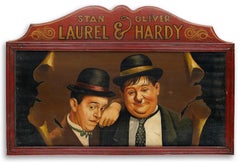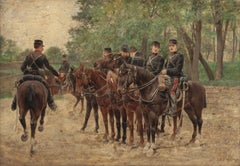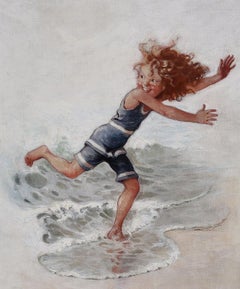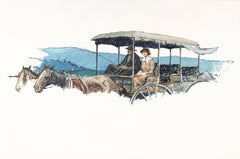Want more images or videos?
Request additional images or videos from the seller
1 of 6
Maxfield ParrishMask and Wig1896
1896
About the Item
- Creator:Maxfield Parrish (1870-1966, American)
- Creation Year:1896
- Dimensions:Height: 22.5 in (57.15 cm)Width: 20.5 in (52.07 cm)
- Medium:
- Period:
- Condition:
- Gallery Location:Fort Washington, PA
- Reference Number:Seller: 41411stDibs: LU38436687682
About the Seller
5.0
Recognized Seller
These prestigious sellers are industry leaders and represent the highest echelon for item quality and design.
Established in 1995
1stDibs seller since 2016
140 sales on 1stDibs
Typical response time: 1 hour
Authenticity Guarantee
In the unlikely event there’s an issue with an item’s authenticity, contact us within 1 year for a full refund. DetailsMoney-Back Guarantee
If your item is not as described, is damaged in transit, or does not arrive, contact us within 7 days for a full refund. Details24-Hour Cancellation
You have a 24-hour grace period in which to reconsider your purchase, with no questions asked.Vetted Professional Sellers
Our world-class sellers must adhere to strict standards for service and quality, maintaining the integrity of our listings.Price-Match Guarantee
If you find that a seller listed the same item for a lower price elsewhere, we’ll match it.Trusted Global Delivery
Our best-in-class carrier network provides specialized shipping options worldwide, including custom delivery.You May Also Like
Study of a dog
Located in Amsterdam, NL
Study of a dog
Oil on paper laid down on panel, 17.5 x 25.5 cm
Provenance
Private collection, the Netherlands
Note:
We are grateful to Mr Fred Meijer for his attribution to Ludolf de Jongh
Ludolf de Jongh was the son of a shoemaker. When his father moved to Rotterdam, the young Ludolf decided to learn art rather than shoemaking and became a pupil of Cornelis Saftleven. Later he studied under Anthony Palamedes in Delft and still later with Jan van Bijlert in Utrecht.
In 1635 he travelled to France with Francis Bacon. Seven years later, in 1642, he returned to the Netherlands when he heard that his mother had fallen ill. He set up a shop in Rotterdam, and his earliest signed paintings date from that year.
According to Houbraken, his travels had caused him to speak French so fluently, that his parents had to learn French in order to speak with him.
De Jongh’s work shows a strong influence from the Utrecht school of Caravaggio admirers, especially Jacob Duck...
Category
Mid-17th Century Old Masters Animal Paintings
Materials
Paper, Oil, Wood Panel
Multifaceted City
By Giancarlo Impiglia
Located in Bridgehampton, NY
An iconic city scene by the renowned Giancarlo Impiglia.
Born in Rome, Impiglia moved to New York in the 70s, where he established a signature style on the shoulders of Futurism and...
Category
2010s Figurative Paintings
Materials
Oil, Wood Panel
The Witness (After Caravaggio)
By Giancarlo Impiglia
Located in Bridgehampton, NY
Part of Giancarlo Impiglia's iconic "camouflage" series, in which, deviating from his signature style, he expresses his classical education, flawless technique, and concerns about th...
Category
2010s Figurative Paintings
Materials
Gold Leaf
Beautiful cubist style oil painting "A Day in the Sun" by Impiglia
By Giancarlo Impiglia
Located in Bridgehampton, NY
A recent, large work by the masterful Giancarlo Impiglia, whose value has been steadily increasing.
Born in Rome, Impiglia moved to New York in the 70s, where he established a signa...
Category
2010s Figurative Paintings
Materials
Oil, Wood Panel
17th Century By Paulus Bor Heraclitus and Democritus Oil on Panel
Located in Milano, Lombardia
Paulus Bor (Amersfoort, Netherlands, 1605 - 1669)
Title: Heraclitus and Democritus
Medium: Oil on panel
Dimensions: without frame 56 x 46 cm - with frame 77 x 67 cm
"Cassetta" frame ...
Category
17th Century Old Masters Figurative Paintings
Materials
Oil, Wood Panel
$71,520 Sale Price
20% Off
H 22.05 in W 18.12 in D 1.97 in
16th Century by Venetian Maestro Deposition of Christ Oil on Panel
Located in Milano, Lombardia
16th Century Venetian Maestro
Title: Deposition of Christ
Medium: Oil on panel
Dimensions: without frame 40 x 25 cm
Painting without frame
Not signed
Previously part of the Canesso Collection, Paris.
Fairs: The International Biennial of Antiques in Florence 2022 (BIAF, Biennale Internazionale dell’Antiquariato di Firenze)
Publications: Bozzetti, modelletti, sketches: dalla collezione di Giorgio Baratti (From the Giorgio Baratti Collection) curated by Anna Orlando, Agnese Marengo and Annalisa Scarpa, Genoa, 2022, pp. 22, 23.
In this precious panel we can admire a lament over the body of Christ by a large group of bystanders among whom we can recognise the Virgin and, in the foreground, St Catherine of Alexandria...
Category
16th Century Old Masters Figurative Paintings
Materials
Oil, Wood Panel
$33,628 Sale Price
20% Off
H 15.75 in W 9.85 in
The Saint-Antoine bridge in Clisson in France
By Louis-Alexandre Cabié
Located in BELEYMAS, FR
Louis-Alexandre CABIÉ
(Dol-de-Bretagne 1853 - Bordeaux 1939)
The Saint Antoine bridge in Clisson
Oil on cardboard
H. 26 cm; L. 29.5 cm
Signed lower left, dated 1907
Provenance: Priv...
Category
Early 1900s French School Landscape Paintings
Materials
Oil, Wood Panel
The bohemians
Located in BELEYMAS, FR
Paul-Louis MARTIN des AMOIGNES
(Saint Benin d’Azy 1850 – Nevers 1925)
The Bohemians
Oil on panel
H. 37 cm; W. 23 cm
Monogrammed lower left "PLM"
Circa 1886
Provenance: Private colle...
Category
1880s French School Landscape Paintings
Materials
Oil, Wood Panel
Portrait of a young fisherman in a landscape
Located in BELEYMAS, FR
Attributed to Godfried SCHALKEN
(Made 1643 – The Hague 1706)
Young fischer
Oil on panel in one board
H. 32.5 cm; L. 25.5 cm
Around 1670/75
Related works:
- Autograph version with nu...
Category
1670s Dutch School Portrait Paintings
Materials
Oil, Wood Panel
Portrait of a woman ironing
Located in BELEYMAS, FR
Paul LUNAUD
(Brantôme 1900 – 1949)
The ironer
Oil on wood
H. 80 cm; W. 64 cm
Signed and dated on the right in the center, formerly signed lower right.
1942
Provenance : Artist's stu...
Category
1940s French School Portrait Paintings
Materials
Oil, Wood Panel
More From This Seller
View AllStan Laurel & Oliver Hardy - Comedians Traveling Road Sign
Located in Fort Washington, PA
This Stan Laurel and Oliver Hardy illustration was used as a traveling show sign for the comedy duo.
Medium: Oil on Wood Panel
Signature: Unsigned
Category
1940s Figurative Paintings
Materials
Wood, Oil, Panel, Wood Panel
French Military on Horseback
By Jules Delaunay
Located in Fort Washington, PA
Date: 1893
Medium: Oil on Panel
Dimensions: 14.50" x 21.00"
Signature: Signed and Dated Lower Right: J. Delaunay. 1893
Category
1890s Figurative Paintings
Materials
Oil, Panel
Little Girl Running from Waves, Original cover for The Saturday Evening Post
By Sarah S. Stilwell Weber
Located in Fort Washington, PA
The Saturday Evening Post Magazine, July 23, 1921 (cover illustration).
Sarah Stilwell-Weber is celebrated for her captivating illustrations of children. While her early work often ...
Category
1920s Figurative Paintings
Materials
Oil, Linen, Panel
Couple in a Horse-Drawn Carriage
By William Henry Dethlef Koerner
Located in Fort Washington, PA
Date: 1923
Medium: Oil on Panel
Dimensions: 24.00" x 36.00"
Category
1920s Figurative Paintings
Materials
Oil, Panel
FFA Student with his Father
By John Philip Falter
Located in Fort Washington, PA
Medium: Oil on Panel
Signature: Signed Lower Right
An FFA student with his father receiving a check for his first delivery of steers to the Omaha stockyard.
Category
20th Century Figurative Paintings
Materials
Oil, Panel
Fashionable Woman
Located in Fort Washington, PA
Signature: Signed & Dated Lower Right
lllustration depicting a genre fashion scene of a woman at her toilette, having her hair pomaded.
Category
1930s Figurative Paintings
Materials
Masonite, Oil, Panel
Recently Viewed
View AllMore Ways To Browse
19th Century Collins
19th Century Procession Paintings
Adolf Schreyer
Aixa Oliveras
Akinola Taoheed
Albrecht Adam
Alexander Sharpe Ross
Alice Murphy
Alpay Efe
American Red Cross Posters Vintage
Andre Favory
Anna Kincaide
Antique Spanish Guitars
Aunt Jemima
Bessie Smith
Bethlehem Painting
Black Nativity
Boardwalk Originals



